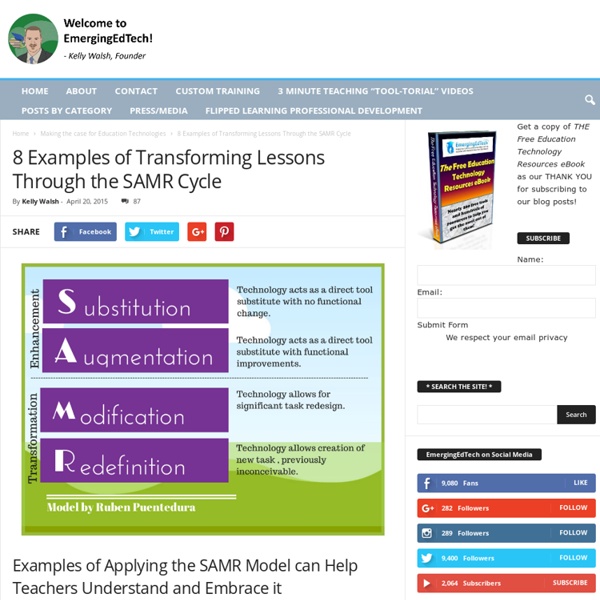6 Common Misconceptions About Blended Learning Infographic
Blended Learning Infograpics 6 Common Misconceptions About Blended Learning Infographic 6 Common Misconceptions About Blended Learning Infographic When implementing blended learning, stakeholders may have preconceived notions about this model of learning. The following outlines some common blended learning myths. The 6 Common Misconceptions About Blended Learning Infographic contains more details, plus questions to ask yourself when considering implementing blended learning:
Push My Thinking: TPACK or SAMR or ? – ED TECH COACHING
**Update 4/26/14: I LOVE the responses to this post; they made me consider a lot of different ways of looking at TPACK and SAMR, and really stretched my thinking. If you read this post, also read the comments- and check out the links that some people have included!I’m going to preface this post by saying that I think both TPACK and SAMR are incredibly useful frameworks- and I use them a lot in my work with education technology.
Using SAMR to Teach Above the Line - Getting Smart by Susan Oxnevad - 1:1 programs, EdTech, technology
For as long as I can remember I have been an advocate for helping teachers understand the stages of technology integration to help them effectively use tech as a tool for learning. I’ve adopted a few different tech integration models over the years, discussed the ideas with administrators for use as a starting point for tech integration, and kept the ideas front of mind as I invent and discover new ways for using technology as a tool for learning. Discussing the stages of tech integration has led to some thought provoking and inspiring conversations, but the ideas have not gained a lot of momentum in my face-to-face teaching environment until now.
9 Ways To Use Social Networks In eLearning - eLearning Industry
The eLearning is a term mostly serving to describe deliberate education with advanced technical user-friendly and intuitive teaching methods. Few of us, however, acknowledge the role different social networks play in teaching us to organize the conventional learning process thus merging it with eLearning step by step. Here you can get a rundown of using social networks in eLearning and how they make it ever more readily accessible and integrated for students. Getting to know how to operate these useful branchy GUIs on their own can make you a power user. 1.
making SAMR work for us – …have laptop, will travel
Technology, when integrated into the curriculum, revolutionizes the learning process. Teachers who recognize computers as problem-solving tools change the way they teach. They move from a behavioral approach to a more constructivist approach.From edutopia.org
The 4 Stages of EdTech - The SAMR Model for Technology Integration
Growth in technology within the education sector has advanced rapidly. This movement has increased the learning capability of students and the techniques of educators. Ultimately the global workforce and society as a whole will benefit positively. As expectations grow and progressively fashionable methods and tools are touted, it is important to keep track of the anatomy of these advances in learning, so that they end up being used most efficiently.
Getting Started With Knowledge Management - eLearning Industry
In the last couple of years I’ve dealt with a few companies that were either unable or unwilling to preserve the knowledge and expertise of their employees. In fact, I was employed at one such organization for quite some time. The company lost money and opportunities, and its image suffered as well, all due to the lack of a comprehensive knowledge management solution. In regards to training, the company put faith in the old “knowledge sharing is king” motto. However, they paid little more than lip service to the concept.
Evaluating Technology Use in the Classroom
Evaluating the use of technology in a classroom environment is not something most administrators are trained to do. It is easy to walk into a classroom and see that every student is using a computer, but how do you really assess if and what type of learning is taking place? In the past, I have had administrators tell me “I walked into the teacher’s room and all the students were on laptops.”
Propp's Morphology of the Folk Tale
Disciplines > Storytelling > Propp's Morphology of the Folk Tale | See also Propp's analysis



